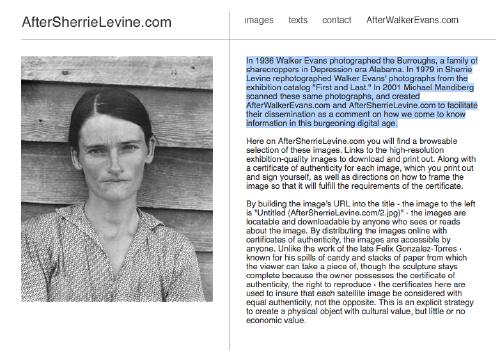From Linda Yablonsky’s article on The Pictures Generation in Art in America:
Bloom remembers seeing Levine’s appropriated Walker Evans photos and thinking, “Oh my God, that is so radical and so insane. It was also brilliant. Sherrie didn’t address any of the esthetic issues, just narrowed it down to the most essential idea about what constitutes ownership of an image, and that was it.”
Joel Wachs, now president of the Andy Warhol Foundation, was a city councilman in Los Angeles in the ’80s and an avid collector of art. In 1984, he saw Levine’s “After Walker Evans” appropriations from 1981 and became the first person to buy one. “I remember having a hard time accepting it at first,” he says. “What was this art, copying someone else’s pictures? Then it started to open me up to a much broader way of thinking about art. The art itself had all the formal qualities I liked and also made people think about male dominance in the art world. Sherrie’s work was $300 and Cindy’s was $800, but some male painters were getting $75,000. When Kruger said, ‘Your body is a battleground,’ that was a clarion call for a political movement.”

Also, hmmm:
In 1936 Walker Evans photographed the Burroughs, a family of sharecroppers in Depression era Alabama. In 1979 in Sherrie Levine rephotographed Walker Evans’ photographs from the exhibition catalog “First and Last.” In 2001 Michael Mandiberg scanned these same photographs, and created AfterWalkerEvans.com and AfterSherrieLevine.com to facilitate their dissemination as a comment on how we come to know information in this burgeoning digital age.
Copying as a creative strategy carries within it the assumption of other copies.
Photo Play [artinamericamagazine via afc]
related: Untitled (300 x 404, after Untitled (Cowboy), 2003 by Richard Prince)
